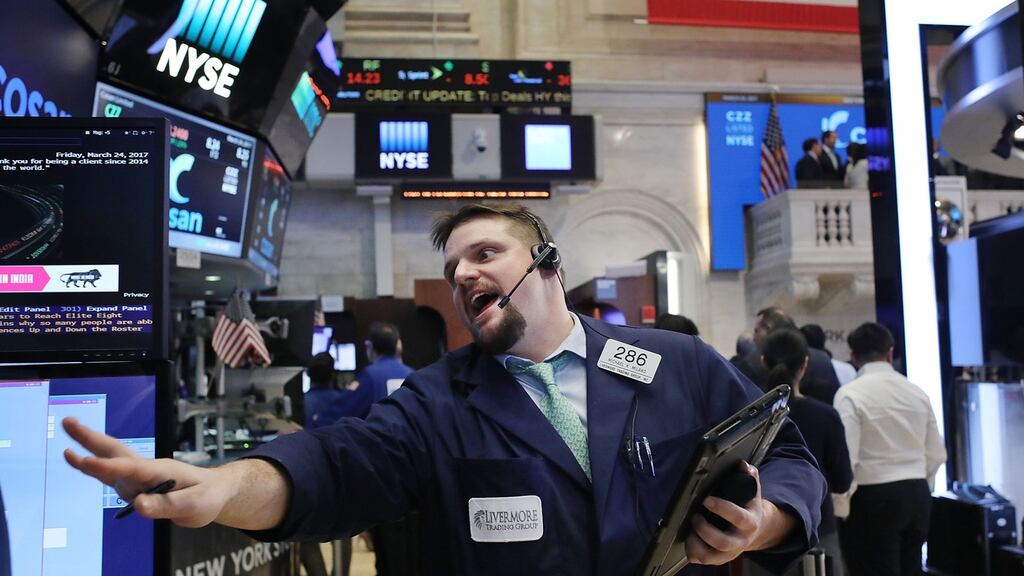The key beneficiaries of the Trump trade in global markets went into reverse on Monday as investors took a bearish view of the US president’s ability to push tax reform and other pro-growth policies through Congress after the collapse of Republicans’ healthcare bill.
Global stocks retreated, US banks briefly slid into correction and the dollar index fell to its lowest level since soon after the presidential election, signalling an at least partial unwind of the so-called Trump trade. Investors turned to the havens of gold and sovereign bonds, as market measures of volatility sprung to their highest levels of the year.
The assets most under pressure in early New York trading were some of the same ones that gained the most since the November election: bank shares, smaller company stocks and the dollar, while safer assets such as US Treasuries rallied.
“The market is saying he used to walk on water and now he does not,” said Vinay Pande, a senior strategist at UBS Wealth Management. “Markets thought [healthcare reform] was one less distraction . . . but the dollar over the weekend took the bulk of the hit.”
Dollar index
The S&P 500, which opened 0.9 per cent lower, was down 0.3 per cent at 2,336 in late morning trade and was on track to close at its lowest level in a month. The dollar index, a measure of the greenback’s performance against a basket of its peers, fell 0.6 per cent to 99.05.
Bank shares briefly fell into correction territory, dropping 9.9 per cent since they had peaked earlier this month. Goldman Sachs and Bank of America, two of the biggest beneficiaries of the Trump trade that buoyed markets in the wake of the election, both slipped 2.5 per cent on opening, and Morgan Stanley fell 4.2 per cent.
“The market never cared about healthcare, it cared about tax reform. And now there seems to be much less space for that,” said Gregory Peters, a senior fund manager at PGIM, Prudential’s $1 trillion (€0.92 trillion) asset management arm. “People are realising that this isn’t the paradigm change they expected the day after the election.”
The dollar has come under increasing pressure since it peaked at the start of the year, and last week’s collapse of the president’s healthcare bill intensified selling of the currency on Monday.
The weakness in the currency reflects doubt over the Trump administration’s fiscal plans to boost the economy and whether the Federal Reserve will tighten policy at a faster pace in the coming year. For the first time this month, market odds of three-quarter point rate rises by the Fed dropped below 50 per cent.
Campaign promise
“Because there was this failure to deliver what was a big campaign promise there is a risk that we will see either more urgency and effort put into strong tax reform or a desire to please the base with protectionist measures, which would be detrimental to the market,” said Isabelle Mateos y Lago, BlackRock’s chief multi-asset strategist. “We’re looking closely at how the political fallout plays out.”
Lower bond yields on Monday also contributed to the weaker tone for the dollar as markets reflected a sense that the Trump administration faces a challenge passing tax reform and fiscal stimulus measures through Congress.
Simon Derrick, chief market strategist at BNY Mellon, said: “Failure to pass the healthcare bill will probably prompt investors to question whether tax reform will prove any easier.” He added higher bond yields were one of the key drivers of the dollar’s post-election rise.
“As such, it is perfectly possible that the week will see yields moderate further and the dollar resume its push lower,” he said.
The dollar was particularly weak against the yen and the pound, down 1.1 per cent in both cases, and 1 per cent lower against the euro.
Markets including the dollar index had briefly risen late on Friday in the hope that the White House could begin to focus on tax reform. But Sue Trinh, Asian forex strategist at RBC Capital Markets, said this optimism "gave way to the realisation very big tax cuts were highly dependent on the savings from replacing Obamacare".
– (Copyright The Financial Times Limited 2017)














